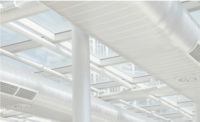Indoor air quality (IAQ) has been a primary topic of discussion over the past year. The COVID-19 pandemic pushed the issue to the front of the national news cycle, while many at the local level tried to find ways to combat the virus. The pandemic added to regular concerns of other health issues, such as the flu and viral sicknesses. Things began returning to normal over the past several months, but with new variants of COVID-19 beginning to arise, IAQ has once again become a very important discussion.
Because COVID-19 and other illnesses are easily transmitted through the air in interior spaces, IAQ will continue to be under a microscope for the foreseeable future. For those in the HVAC manufacturing industry, the need to provide solutions to improve IAQ is more important than ever.
Being cognizant of IAQ is vital to building and facility managers who operate spaces that are regularly occupied. During the winter, the threat of airborne pathogens is increased due to both doors and windows remaining shut to escape the frigid air outside. With no natural ventilation, harmful viruses and bacteria can easily spread from person to person if the air isn’t conditioned correctly. Providing optimal IAQ levels throughout buildings is a must.
Mechanical HVAC systems are one of the best weapons when it comes to combating airborne pathogens and enhancing IAQ. Whether it’s a school, restaurant, or hotel, HVAC units are equipped with the necessary tools to impact the overall quality of indoor air.
For example, dedicated outdoor air systems (DOAS) are the ideal solution for effectively and efficiently conditioning high volumes of outside air for ventilation. These types of systems come with a programmable microprocessor-based system that provides a wide range of application-driven control strategies. But, the main benefit for systems like these is their ability to bring fresh, clean outdoor air inside while pushing contaminated air outdoors.
The DOAS is just one HVAC unit that can provide the necessary tools to enhance IAQ. Many other HVAC systems can do the same if properly used or equipped with upgraded components. For those systems, there should be a focus on three areas: filtration, controlled ventilation, and dehumidification. Addressing those three areas can make the difference between having clean air to breathe indoors and being at risk of airborne viruses.
Optimum Filtration Needs
Before the pandemic, ASHRAE recommended the use of MERV-8 or MERV-10 filters in HVAC units. The introduction of COVID-19 made ASHRAE reconsider those recommendations. In the aftermath, it was determined that MERV-13 filtration was the best option to better improve IAQ. Because they increased the standards, buildings are seeing an improvement in the quality of air indoors.
Ultraviolet lights provide a secondary option for filtration. The CDC has been at the forefront of recommending UV lights, doing so before the pandemic struck. Hospitals and sterile work environments have been using UV lights for decades due to their effectiveness in killing certain bacteria. Ultraviolet germicidal energy (UV-C) has shown the ability to inactivate viruses, bacteria, and fungi. Needlepoint bipolar ionization is a third tool that can be equipped to an HVAC unit to better enhance IAQ. This instrument delivers positive and negative ions via the ventilation system to attach to airborne particulates, cluster, and filter them from the air.
Maximize Fresh Air Intake
A general rule of thumb when it comes to air quality is that the air outside is much cleaner and fresher than the air indoors. This means it’s important to get as much of the clean outside air into interior spaces. Adequate ventilation is a key step in limiting airborne pathogens that could spread. Controlled ventilation, which is available through mechanical HVAC systems, allows those in charge of managing the facilities to control the airflow and regulate how much outside air makes it indoors. While pumping outside air indoors, the system is also pushing contaminated air outside, creating an atmosphere that has fresh air for occupants to breathe.
Manage Humidity Levels Indoors
Humidity also plays a major role in IAQ. Whenever air is pumped indoors, the moisture associated with the air comes with it. Too much humidity can make the air feel sticky and uncomfortable for occupants while lower levels of humidity can make the air feel dry. In addition to comfort levels, humidity is also significant for organic growth. If there is too much moisture in the air, buildings and units can quickly grow mold or mildew, some of which cannot be seen, which can be dangerous for building occupants.
Mechanical HVAC equipment is designed to handle latent loads associated with outdoor air. These systems allow building owners and facility managers to control humidity levels. The sweet spot for relative humidity is between 40%-60%.
Whether you are a school administrator in charge of students daily, a restaurant owner, or a manager of a hotel, IAQ should be emphasized. Improving your IAQ with increased ventilation, optimal filtration, and better management of humidity will help limit airborne pathogens in your space and ensure optimal occupant comfortability.




